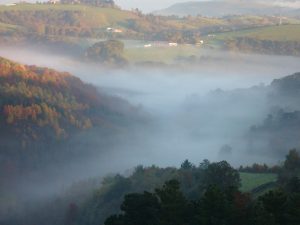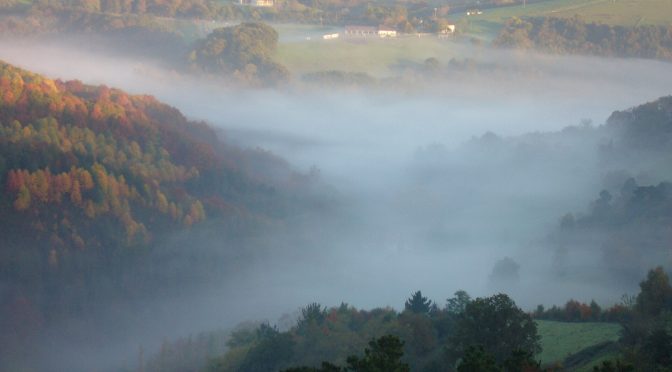One of the most magical scenes from the Basque Country is the valleys filled with a gentle fog, hiding the deepest recesses as the mountains peak over the top. It’s something that is simply very rare here in New Mexico. But, for ancient Basques, that fog wasn’t always welcome and indeed it brought supernatural diseases that humans had little ability to fight. The supernatural air – Aideko – could only be countered with prayer or magic.

- Aideko literally means “of the air,” though this spirit has multiple names: Aide, Aidetikako. Aideko is typically invisible – like the air – but can take the form of a mist or fog, when it is called Lauso or Lainaide. It was believed that the air could intervene in human affairs, sometimes for good and sometimes for bad. In its bad form, it is also called Aidegaxto. The idea of Aideko extends beyond the Basque Country, as far as Cantabria.
- In basic Basque belief, the world was split into two parts. There was the natural, or berezko, part that was understood and could be explained. Then there was the aideko part, the supernatural that could not be explained. All of the supernatural came from the air – aideko. Natural forces could be used to influence berezko, but only prayer and magic could intervene against aideko.
- Similarly, Aideko was responsible for all diseases whose causes were not known. For example, it was believed that black fever (cholera) was brought to the people by Aide, who had come in the form of a low mist that spread through the valleys and villages. One remedy was to parade a flock of sheep through the streets, as the sheep would catch the fever and spare the people. A “rotten fog” that lingered for days could ruin crops and harm animals. In such cases, Aideko was known as Lainaide, a fog that was sent by the sea to destroy crops and livestock.
- There are stories that the end of the Jentilak was ushered in by the coming of clouds of fog. In some stories, the clouds simply heralded their end, but in others, the clouds literally chased the jentilak to their doom, forcing them underground where they remain buried. Again, the clouds bring death with them.
A full list of all of Buber’s Basque Facts of the Week can be found in the Archive.
Primary sources: Barandiaran Ayerbe, José Miguel de. Aide, Aideko, Aidetikako. Auñamendi Encyclopedia, 2024. Available at: https://aunamendi.eusko-ikaskuntza.eus/en/aide-aideko-aidetikako/ar-7359/; Aideko, Wikipedia; Hartsuaga Uranga, Juan Inazio. Laino Marismea. Auñamendi Encyclopedia, 2024. Available at: https://aunamendi.eusko-ikaskuntza.eus/en/laino-marismea/ar-153827/
Discover more from Buber's Basque Page
Subscribe to get the latest posts sent to your email.



Greetings, Interesting! when I was a kid ( a long time ago!) after sheep shearing, we had to skirt and separate the wool –the good, the bad and the ugly. The elders would call the ugly wool “lainaide”. Maybe a carry over when the Bearn was part of the Basque region. Monique
That’s very interesting. Some day, I’ll have to look more into the connections between the Basque Country and Bearn.
Really interesting Blas! Eskarrik Asko!
Camille Paradis et al. Impacts on human health potentially caused by exposure to an unprecedented Ostreospis spp bloom in the bay of Biscay, French Basque Coast. Wilderness Environ Med.2024 march;35(1):13-21. DOI: 10.1177/10806032231220405
Lainaide is coming back each summer on the Bask Coast between july and september…it’s a curse!!!